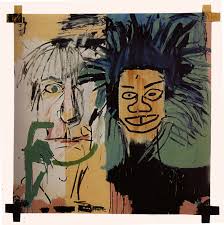Collaborative Artist Research
- bethanyjackson95
- Apr 13, 2017
- 3 min read
After working on the numerous collaborative painting and drawing pieces with fellow artist Paige Phillips, I decided to look into artists that also created collaborative work as an area of extra research and interest in my own project.
Through initial research I came across collaborations between Andy Warhol and Jean Michael Basquiat and then Raymond Pettibon and Marcel Dzama.
Pettibon and Dzama's most recent collab work is called “Let us compare mythologies” which is a follow on exhibition to the earlier 2015 show held at the gallery’s New York location, titled “Forgetting the Hand.”. Dzama and Pettibon only began collaborating as recently as 2015, when the two jointly-executed drawings in a style—known as “exquisite corpse”—originally favored by the Surrealists, in which “a partner is only given portions of an otherwise concealed drawing to work on.” In following this method, Dzama and Pettibon would swap drawings mid-work, thus allowing different parts of the same drawing to be completed at the hand of the other. Because of this, “it is nearly impossible to determine who made what, which indicates how both strove to assimilate the other’s vision or anticipate his response,” states the press release.
This style of working together is similar to the way in which myself and Paige would work by swapping drawings part way through the production process.
The collaborative relationship between Andy Warhol and Jean-Michael Basquiat developed in the 1980s after they were introduced to each other by art dealer Bruno Bischofberger. This relationship – both personal and professional, the good and the bad – was detailed in The Andy Warhol Diaries. Beginning in 1976, Andy Warhol began calling his assistant, Pat Hackett, every morning at 9am to rehash the previous evening’s goings-on. Warhol name-dropped on the regular – no one was off limits and he could be quite cutting and catty in his offhand remarks about his contemporaries. He gossiped about Liza Minnelli and Mikhail Baryshnikov doing cocaine, “just shoveling it in,” and opined about Salvador Dali’s latest work (“He is smart.”). After Warhol finished detailing his night to Pat (which could often take up to 2 hours a day!), she would hang up and immediately transcribe her conversation with Warhol. They upheld this funny little tradition for many years though it wasn’t until 1989, two years after Warhol’s death, that she was able to edit down the over 20,000 pages of daily correspondence into the now-celebrated 800 page tome, The Andy Warhol Diaries.Jean-Michael Basquiat made his first appearance in the Diaries on Monday, October 4, 1982. Warhol’s first impression of the young artist was a lukewarm mix of annoyance and condescension. In that first October 4 entry, Warhol said of Basquiat, “He’s just one of those kids who drives me crazy…and then Bruno [Bischofberger] discovered him and now he’s on Easy Street… had lunch for them and then I took a Polaroid and he went home and within two hours a painting was back, still wet, of him and me together. And I mean, just getting to Christie Street must have taken an hour. He told me his assistant painted it.”Warhol’s weariness of Basquiat never quite ever fully went away even as the two artists became close and began their years-long professional collaborative relationship. Their contemporaries said much about the pair’s relationship; cynics viewed Basquiat as a fame hungry leech and Andy as an opportunist who took advantage of the young artist’s relative naivetÈ. Others took a less pessimistic view. Ronny Cutrone was quoted in Warhol: The Biography by Victor Bockris saying, “The relationship was symbiotic. Jean-Michel thought he needed Andy’s fame, and Andy thought he needed Jean-Michel’s new blood. Jean Michel gave Andy a rebellious image again.”

































Comments